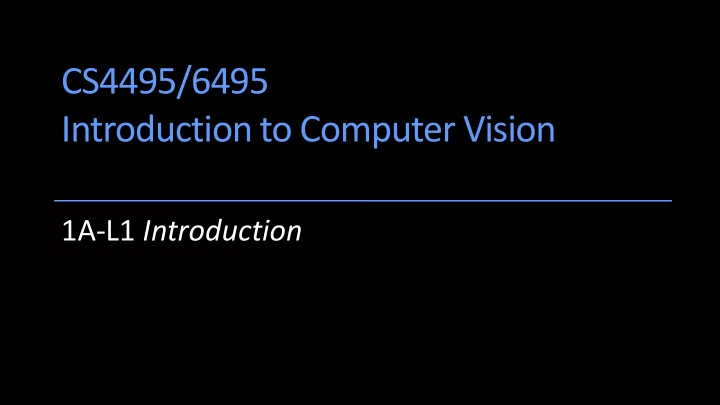

CS4495/6495 Introduction to Computer Vision 1A-L1 Introduction
Outline • What is computer vision? • State of the art • Why is this hard? • Course overview • Software
Why study Computer Vision? • Images (and movies) have become ubiquitous in both production and consumption. • Therefore applications to manipulate images (movies) are becoming core. • As are systems that extract information from imagery • Surveillance • Building 3D representations • Motion capture assisted
Why study Computer Vision? • But most of all… It is a really deep and cool set of problems!
Every picture tells a story Goal of computer vision is to write computer programs that can interpret images Steve Seitz
Making sense of a picture • We want to extract meaning out of an image/sequence of images • This is different from image processing, which is mainly concerned with transforming images • Image processing operations such as blurring, thresholding etc. are often used as part of CV algorithms
Making sense of a picture • Look at this scene carefully…
Making sense of a picture • What items could you identify? How did you recognize them? • What about other objects/spaces/time of day etc.?
Current state of the art • Can computers match (or beat) human vision? • Yes and no (but mostly no!) • Humans are much better at “hard” things • Computers can be better at “easy” things • Though getting really good at labeling using machine learning techniques. Only a little on that in this course. Steve Seitz
Current state of the art • The next slides show some examples of what current vision systems can do
Optical character recognition (OCR) Technology to convert scanned docs to text If you have a scanner, it probably came with OCR software License plate readers Handwritten Digit recognition http://en.wikipedia.org/wiki/Automatic_number_plate_recognition Steve Seitz
Face detection and more… • Most digital cameras can detect faces…
Face detection and more… SONY “Smile Shutter” • Some can detect blinking or smiling…
Face detection and more… • And some can even recognize you!
Object recognition (in supermarkets) • Evolution Robotics Retail developed LaneHawk ™, a retail loss-prevention solution that helps turn bottom-of- basket (BOB) losses and in-cart losses into profits in real time. • The company was acquired by Datalogic 5 years later!
Object recognition (in mobile devices!)
Special effects: shape capture The Matrix movies, ESC Entertainment, XYZRGB, NRC Steve Seitz
Special effects: motion capture Pirates of the Caribbean Industrial Light and Magic www.ilm.com Steve Seitz
Earth viewers (3D modeling) Image from Microsoft’s Virtual Earth (see also: Google Earth) Steve Seitz
Smart cars Mobileye Slide content courtesy of Amnon Shashua
Smart cars are here!
Sports Sportvision first down line Steve Seitz
Vision-based interaction (and games) Nintendo Wii has camera-based IR tracking built in. Steve Seitz
But the game changer:
Security and surveillance
Medical imaging 3D imaging Image guided surgery MRI, CT Grimson et al., MIT Steve Seitz
Current state of the art • This is just a taste of the state of the art. • Some of these are less than 5 years old, most less than 10 • This is a very active research area, and rapidly changing • Many new apps in the next 5 years
Why is this hard?
Simple scene right? Dark square Light square Edward Adelson
Really? Edward Adelson
Really! Edward Adelson
Vision is NOT Image Processing • In the previous example, the two squares have exactly the same measurement of intensity. • So, seeing is not the same as measuring properties in the image. • Rather, “seeing” is building a percept of what is in the world based upon the measurements made by an imaging sensor.
Building models from change (1) Michael Black
Building models from change (1) Left Image Michael Black
Building models from change (1) Right Image Michael Black
Building models from change (2) Dan Kersten http://vision.psych.umn.edu/users/kersten/kersten-lab/shadows.html
Building models from change (3) Dan Kersten http://vision.psych.umn.edu/users/kersten/kersten-lab/shadows.html
Interpreting images • The previous example is one where the human system is again “wrong” – nothing is moving upwards. But feels like the best interpretation. • Our goal is to develop your understanding of some of what it takes to go from image to interpretation.
Course overview
A little bit of pedagogy…
A little bit of pedagody … Computational Models (Math!)
A little bit of pedagody … Computational Models (Math!) Algorithm
A little bit of pedagogy… Computational Models (Math!) Scene Ground truth Algorithm Real Images
A little bit of pedagogy… Computational Models (Math!) Introduction to Computer Vision Algorithm Real Images
Topic outline I NTRODUCTION 1. I MAGE P ROCESSING FOR C OMPUTER V ISION 2. C AMERA MODELS AND VIEWS 3. F EATURES AND MATCHING 4. L IGHTNESS AND B RIGHTNESS 5. I MAGE MOTION 6. M OTION AND TRACKING 7. C LASSIFICATION AND R ECOGNITION 8. M ISCELLANEOUS OPERATIONS 9. 10. H UMAN V ISION
Problem sets • 8 problem sets (PS0 to PS7)
Policies • Blackboard-level conversations OK, esp. on forums • Write your own code • Ask questions on forum first, then contact TA/instructor
Exam • There will be a final exam. • It’s not hard – it simply designed to require folks to go back over the slides (and text) and remember what we’ve learned.
Grading • The general rubric is 85% of the final grade is based upon the problem sets. • 15% is the final.
Software • Embedded programming exercises (in Octave) • Matlab/Octave: Primary platform for exercises, problem sets • Python + NumPy + OpenCV: You can submit your problem set solutions in Python, but there will be very limited support
Learning goals What do you expect to learn from this course? • Note down somewhere and track your progress. • In the end, you may not have learnt everything you expected. • At the same time, you may have learnt some things you did not know about at all
Recommend
More recommend